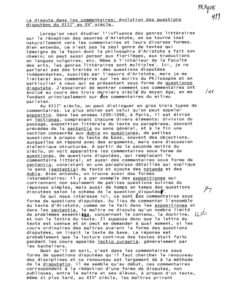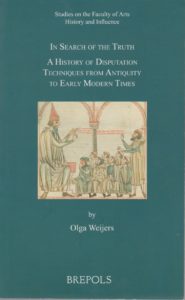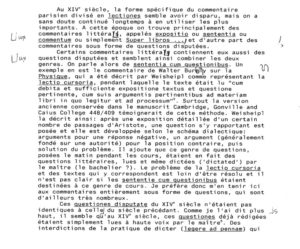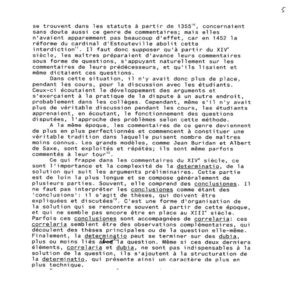From this point on, I centered my research principally on the third and most important teaching method in the Medieval universities: the disputatio. Thus, the third theme of Part III is consecrated to disputation techniques.
Disputation at the Faculty of Arts
My first small study on the disputation was limited to the arts faculty in Paris: La ‘disputatio’ à la Faculté des arts de Paris (1200-1350 environ). Esquisse d’une typologie; it appeared in 1995 (see Publications, Book 9) It concerns the thirteenth and the beginning of the fourteenth century (the mention 1350 in the title is erroneous) and tries to explain how the disputation developed out of the common teaching methods. The first chapter briefly discusses the lectio or ‘lecture’, the reading and commenting of the basic texts by the master before his students, at the arts faculty; the second chapter addresses the questio: the questions raised during this reading. The second and largest part of the book then presents the disputatio, the discussion of important or difficult questions separated from the reading. First, the study focuses on the mentions of the disputation in the statutes of the university of Paris, then the surviving texts in the various disciplines themselves: grammar, dialectics, and the other disciplines, mainly based on Aristotle’s treatises (physics, metaphysics, psychology, etc.). Finally, some pages mention the disputatio de quolibet, the disputation on any question raised by anyone of the attenders (we have only some small traces of this for the arts faculty in this period). In spite of its limited scope, it may still be a useful publication because of the extensive examples showing the structure of the disputation: after the formulation of the question, arguments are given both for the affirmative and for the negative answer, after which the master gives his solution (usually one of the two positions discussed, but he may propose a different way by means of distinction) and refutes the arguments going against this opinion. However, in a more developed form, one or more bachelors give provisional answers (the respondentes) and others oppose to them (the opponents) before the master ‘determines’ the question.
After this introductory volume, I extended my research to the arts faculties in other universities: La ‘disputatio’ dans les Facultés des arts au moyen âge; this volume appeared in 2002 (see Publications, Book 14). In the first part, I extended my study of the disputatio at the Paris faculty of arts to the fourteenth and fifteenth century; part II concerns Oxford and Cambridge, part III the universities of southern France, part IV the Italian universities, and part V the arts faculties of Central Europe. All these parts first contain a discussion of the statutes mentioning the disputation and afterwards offers examples of subsistent texts.
Disputation in the other faculties
During the following years I extended my research to the disputatio in other faculties and published a third volume on the topic: Queritur utrum. Recherches sur la ‘disputatio’ dans les universités médiévales (2009, see Publications, Book 18). Here, I tried to give an account of the function and techniques of the disputation in the Faculty of theology, in the Faculty of Law, and in the Faculty of Medecine, maintaining the same scheme of comparison between the statutes and the texts. Of course, the number of sources I could study for the various faculties is very limited, but I hope that this study still gives an adequate idea of the subject. I could count on several colleagues to comment on my drafts and preserve me from too serious errors, for instance Louis Jacques Bataillon, Frank Soetermeer, Manlio Bellomo, Tiziana Pesenti; they all contributed in important ways to the final result.
Finally, I was confident enough to imagine a synthesis of the whole subject in a study written, in English, for a large public. The small volume entitled In Search of the Truth. A History of Disputation Techniques from Antiquity to Early Modern Times (2013, see Publications, Book 22) not only gives a summary of the matter treated in the previous studies, but also places it in a wider historical context: starting with comparable forms of discussion in Antiquity, it addresses the relation between dialogue and disputation and the probable origins of the disputation, the use of disputation outside the universities, during Renaissance and Early Modern times, and in other cultures. The publication being recent and easily available, I will not give abstracts here; I just reproduce the Table of Contents.
Table of Contents:
Introduction
I. Antiquity
– Disputation, dialectic and rhetoric
– Scholastic exercises
– The teaching of philosophy
– Dialectic and rhetoric in later times
– Literary genres
– The role of Aristotle
– The role of the “Sophistici Elenchi”
– The method of the “aporiai”
– The method of “zetemata kai luseis” after Aristotle
– The dialectical disputation after Aristotle
– Public disputation in late Antiquity
II. Disputation and dialogue
- Dialogue in Antiquity
- The Patristic dialogue
- The didactic dialogue
- The dispute poems
- Doctrinal controversies
- Medieval philosophical dialogues
- The Renaissance dialogue
- The relationship between dialogue and disputation
III. Origins of the Medieval disputation
- The heritage of Boethius
- The development of the eristic disputation
- The quaestio method
- Public debates
- The development of the quaestio rfising from the reading of texts
- The juridical disputation
- Disputation in science and medecine
- Conclusion
IV. The Medieval disputation before the university era
– Terms and definitions
– Reasons and tools of rational inquiry
– Disputations in the various disciplines
– The role of rhetoric
– Conclusion
V. Disputation in the Medieval universities: general analysis
– The various kinds of disputation
– Disputed questions in commentaries
– Disputation as exercise
– Disputation as a method of teaching and research
– The quodlibetical disputations
– Examination ceremonies
– Literary and polemical disputations
– Some general features
– The nature of the arguments
VI. Disputation in the Medieval universities: some examples
VII. Renaissance Disputation
- Transition: the 15th century
- The Humanist-scholastic debate
- Change in character in the Reformation
- Disputation in Renaissance universities
- Differences with the medieval disputation
- Quodlibetical disputations in the 15th and 16th centuries
- Conclusion
VIII. Disputation in Early Modern Times
– Between the 16th and 17th century: the Jesuits and disputation
– Disputation and logic
– Disputation and dissertation: some general remarks
– The “Modern method” according to the treatises on disputation
– The new disputation in practice
– The decline of the disputation and the German exception
– Disputation in early-modern England, France, Spain and Italy
– Disputation in the German universities
– Disputation in the Low Countries
– The 19th century and beyond
IX. Disputation outside the universities and in the vernacular
– Disputation in non-academic schools
– Disputation outside the schools
– Disputation in polemical context
– Parallel genres in Latin and vernacular
– Imitation of the disputation in literary texts
X. Forms of disputation in other cultures
- Discussion in Jewish culture
- The Arabic and Islamic tradition
- Discussion in distant civilisations
Conclusion
- Essential features
- Dissent or critical thinking?
- Similarity and contrast
- Intellectual freedom and confidence
Bibliography
List of illustrations
Index
Articles on disputation
My research on the disputation has of course found its expression in many smaller studies, published in collective volumes and periodicals, parallel to and preparing the monographies. See for instance Publications, Articles
n° 31: on the method of the disputatio, published in a volume on the teaching of the various disciplines at the arts faculties of Paris and Oxford (proceedings of a congress in Paris)
35: on the difference between dialectical and scholastic disputation (paper given at the Académie des Inscriptions et Belles-Lettres)
36: on the disputation at the arts faculties in Southern France (prepared for a colloquium in Fanjeaux)
40: in Dutch, on the disputation as a means of understanding (paper given before the Royal Dutch Academy of Arts and Sciences)
45: on disputed questions and the scholastic disputation (in the context of a volume on Gersonides)
57: (in a volume on the historical tradition of controversy), on the medieval disputation (paper given at a congress in Taipei)
58: on the disputation as a means of dialogue between scholars (paper given at a colloquium in Montpellier)
59: on the development of the disputation in the Renaissance (paper given at a colloquium in London 2009)
62: on the various kinds of disputation in arts, theology and law (paper prepared for a congress on the various forms and functions of the disputatio between 1200 and 1800)
Most of these articles are the printed results of papers given at various places, or at least prepared for these occasions. One paper, given at Prague during a colloquium on the forms of the reception of Aristotle (Forme recepce Aristotela) organised by the Centre for Medieval Studies in 1999, has remained unpublished. It is about the presence of the disputation in commentaries, or the way in which disputed questions developed between the thirteenth and fifteenth century. I reproduce parts of the typescript I clearly used for my reading of the paper, including corrections, underlining instead of cursive, etc.
Cliquez sur les images pour les agrandir

The interrupted sentence continues as follows: l’habitude de lire les Questiones d’un prédécesseur. Follow examples of the commentaries on the Topics of Boethius of Dacia, Adenulphus of Anagni and Angelus of Camerino (see also article n° 37). The paper continues:
Here, examples from commentaries by Albert of Saxe and Nicole Oresme are provided. For the fifteenth century, I took commentaries of Johannes Versor and Georges of Bruxelles as example. Here is the conclusion:
I think the ‘prudence’ with which I presented ‘some conclusions’ was justified. The very limited number of commentaries, especially from the fifteenth century, imposes such a careful attitude. However, the paper has the advantage of showing at least some features of later commentaries. The same topic, of the disputatio being at the origin of systematic disciplines, is discussed in article n° 37 (see under III, 2). This still seems a valid appraisal.




Commentaires récents